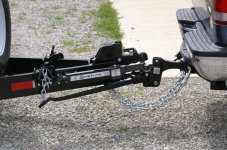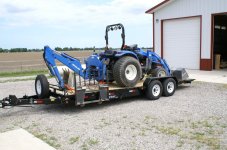A WD setup has a couple components to it. There is a special shank that goes in the receiver. You need to buy a heavy enough rated ball for it too. Then there are the bars and the brackets. The brackets get permanently mounted to the trailer. Most just bolt on so you could theoretically move them from one trailer to another, but that would be a major pain and you'd be better off getting extra brackets if you were doing that. The bars are the part that is most noticeable. They slip into a bracket in the shank and then attach to the brackets on the trailer. Mine uses a short pipe as a lever to snap up the trailer brackets. Then you put a safety pin in them to keep them from accidentally popping open.
I use that shank all the time, so it is always there. The extra work is the bars, which really only take an extra minute or two to install. You get the ball lined up and connected first, then put the bars in, hook them to the trailer brackets and snap them up.
Optionally you can also add anti sway control. That is the extra thing you see in wolfpack's first photo (the gray bar along side the trailer A-frame tongue that says Draw-tite on it)). I don't have one and never see any sway at all. I can see with campers that have big side cross-sections it might make more sense for control in crosswinds, but I suspect it is not needed for most equipment trailer use. That would take some additional time to connect if you had one.
It sounds like your receiver is rated fine for what you are doing. That is good to know. In my case I needed to do something to get within the specs, and I elected to go WD. I don't think it makes life any easier, it just puts me well within my receivers limits, so I am safe and stable. A bigger receiver would have been a bit easier in the long run as there would be no bars to mess with, but it isn't that hard to do.



